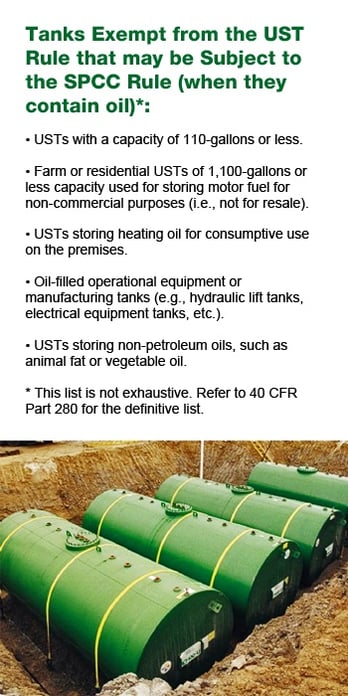Underground Storage Tanks (USTs) Subject To The SPCC Rule
 The United States Environmental Protection Agency (USEPA) recently announced revisions to the federal Underground Storage Tank (UST) Rule (40 CFR Part 280). Changes include adding secondary containment for new and replaced tanks and piping, adding operator training requirements, and adding operation and maintenance requirements, among others. Click here for a link to the USEPA amendment, or here for a Free Guide to learn more.
The United States Environmental Protection Agency (USEPA) recently announced revisions to the federal Underground Storage Tank (UST) Rule (40 CFR Part 280). Changes include adding secondary containment for new and replaced tanks and piping, adding operator training requirements, and adding operation and maintenance requirements, among others. Click here for a link to the USEPA amendment, or here for a Free Guide to learn more.
Underground tanks that fall under the federal UST Rule include those that have a capacity greater than 110-gallons of motor fuels, jet fuels, distillate fuel oils, residual fuel oils, lubricants, petroleum solvents, or used oils.
However, Owners/Operators of underground tanks that are exempt from the UST Rule are often unaware that their tanks could still be required to follow the federal Spill Prevention, Control, and Countermeasure (SPCC) Rule (40 CFR Part 112). This misunderstanding may be because the SPCC Rule is generally recognized as the aboveground storage tank (AST) rule. After all, the SPCC Rule specifically excludes underground tanks subject to all of the technical requirements of the UST Rule.
So when does an underground tank fall under the SPCC Rule? To start, the SPCC Rule applies to facilities that:
- Are non-transportation-related (i.e., not subject to the USDOT);
- Could reasonably be expected to discharge oil to navigable waters or adjoining shorelines in quantities that may be harmful (e.g., a sheen); and
- Have an aggregate aboveground oil storage capacity of more than 1,320-gallons, or an aggregate underground storage capacity (completely buried) greater than 42,000-gallons (of oil not regulated by the UST Rule). Note: Only containers with a capacity of 55-gallons or more are applicable.
As noted in the third item, underground storage tanks must adhere to the SPCC Rule when they have a capacity greater than 42,000-gallons (of oil not regulated by the UST Rule, and meet the criteria of the first two items).
Also, underground tanks must conform to the SPCC Rule if a facility is already otherwise subject to the rule (because it has an aboveground storage tank capacity greater than 1,320-gallons), AND when it has underground storage as described in the image above. Such underground storage tanks must be designed and constructed as noted here:
Underground storage tanks accountable to the SPCC Rule:
- Must be designed and constructed in accordance with good engineering practice.
- Must be compatible with the product stored and conditions of storage such as pressure and temperature.
- Must be provided with secondary containment.
- Steel tanks installed on or after January 10, 1974 must be protected from corrosion, and be regularly leak tested.
- Must be engineered or updated in accordance with good engineering practice to avoid discharges (e.g., high-level alarm, overfill prevention device, etc.).
- Underground piping installed after August 16, 2002 must be corrosion protected.
- Underground piping must be integrity and leak tested at the time of installation, modification, or replacement.
It must also be noted that underground storage tanks bound by the UST Rule, if located at an otherwise SPCC-regulated facility, may need to abide by certain additional requirements of the SPCC Rule, including:
- Sized secondary containment of loading/unloading racks.
- General (a.k.a. “appropriate”) containment of undiked areas (e.g., loading/unloading areas [i.e., areas where oil transfers occur that are not defined as a “rack”], aboveground piping, etc.).
- Prompt correction of leaks from piping, pumps, valves, etc.
- If a section of underground piping is exposed for any reason, it must be inspected for deterioration; and if corrosion damage is present additional examination is required and corrective action taken as appropriate.
- Associated aboveground piping, valves, and appurtenances must be regularly inspected.
- Be located and identified as “exempt” on the SPCC Plan Facility Diagram.
Because a loading/unloading rack, or other transfer area, is not typically part of the underground storage tank system, it is not subject to all of the technical requirements of 40 CFR part 280. Therefore, such a loading/unloading rack is regulated under the SPCC regulations in the same manner as any other transfer equipment or transfer activity located at an otherwise SPCC-regulated facility.
Additional and/or more stringent requirements may exist in a state-approved program under 40 CFR part 281 and they may also impact SPCC applicability. For example, a state may choose to regulate an underground storage tank used for storing heating oil for consumptive use on the premises where stored. Thus, under the state program the tank is subject to all the technical requirements of a 40 CFR part 281 program and, therefore, exempt from the SPCC rule. Owners/Operators should consider any state UST program approved under 40 CFR part 281 when addressing applicability issues associated with completely buried tanks.
Thanks for reading.
Sincerely,
Bill Frye "The Fuel Farm Guy" (with apologies to Bill Nye The Science Guy)
More helpful articles from Q Ware.
Bill Frye
Bill is a Senior Project Engineer with the C&S Companies environmental group. His expertise is in the compliance and design of oil/petroleum and chemical storage facilities. Nicknamed, Bill Frye the Fuel Farm Guy.